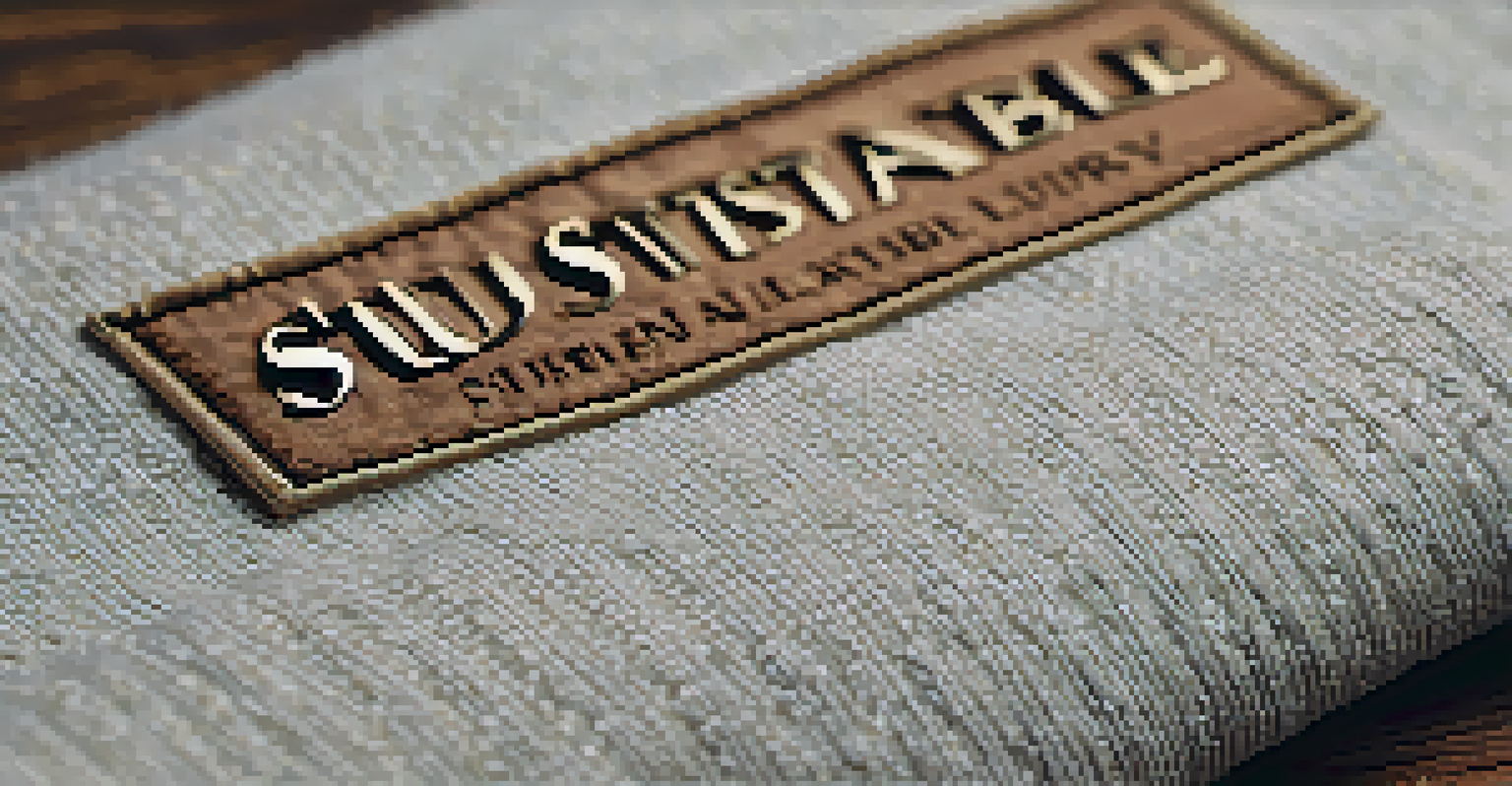Sustainable Luxury Fashion Shows: Trends and Impacts

The Rise of Sustainable Luxury Fashion Shows
In recent years, the fashion industry has seen a notable shift towards sustainability, with luxury fashion shows leading the charge. Designers are increasingly recognizing the importance of eco-friendliness, which is reflected in their collections and presentation styles. This trend not only aims to reduce environmental impact but also responds to a growing consumer demand for transparency and ethical practices in fashion.
Fashion is the armor to survive the reality of everyday life.
Luxury brands are now curating shows that highlight their commitment to sustainability, showcasing materials that are organic, recycled, or upcycled. For instance, brands like Stella McCartney have long been at the forefront, promoting their eco-conscious ethos through innovative designs. By incorporating sustainable practices into their runway presentations, they are not just selling clothes but also advocating a lifestyle change.
As these events gain momentum, they serve as a platform for raising awareness about important environmental issues. Attendees and viewers are increasingly influenced by the narratives presented during these shows, encouraging them to consider the origins of their clothing and the broader implications of their fashion choices.
Key Trends in Sustainable Luxury Fashion Shows
Fashion shows are evolving, with trends that prioritize sustainability now taking center stage. Noteworthy trends include the use of digital platforms for showcasing collections, which minimizes the carbon footprint associated with traditional runway shows. This shift not only makes fashion more accessible but also aligns with the industry's goals for reducing waste.

Another trend is the integration of diverse models to promote body positivity and inclusivity, which reflects broader societal changes. By broadening the definition of beauty, fashion shows are redefining luxury and making it more relatable to a wider audience. This approach resonates deeply with consumers who value diversity as part of their sustainable lifestyle.
Sustainability Drives Fashion Change
The fashion industry is increasingly prioritizing sustainability, with luxury shows showcasing eco-friendly practices and materials.
Furthermore, brands are increasingly collaborating with environmental organizations and artisans to create unique collections. These partnerships not only support local economies but also highlight the importance of craftsmanship and sustainability, ensuring that luxury remains synonymous with quality and responsibility.
The Role of Technology in Sustainable Fashion
Technological advancements are playing a crucial role in the evolution of sustainable luxury fashion shows. Innovations like 3D printing and virtual reality allow designers to create and present their collections without the need for excessive resources and materials. This technology not only reduces waste but also opens up new avenues for creativity in design.
The greatest danger for most of us is not that our aim is too high and we miss it, but that it is too low and we reach it.
Moreover, blockchain technology is gaining traction in the fashion industry, helping brands track the supply chain and ensure ethical sourcing. This transparency builds trust with consumers who are increasingly aware of the impact of their purchases. By utilizing technology for accountability, brands can enhance their reputation while promoting sustainability.
Ultimately, the intersection of technology and sustainability is paving the way for a more responsible fashion industry. As luxury brands embrace these tools, they can create a lasting impact on both the environment and consumer behavior, encouraging a shift towards more mindful purchasing.
The Impact of Sustainable Luxury Fashion on Consumer Behavior
As sustainable luxury fashion shows gain popularity, they are shaping consumer behavior in profound ways. More shoppers are becoming conscious of the environmental and ethical implications of their purchases, leading to a rise in demand for sustainable products. This change in mindset reflects a broader cultural shift towards responsible consumption.
Luxury brands that showcase their commitment to sustainability are often rewarded with increased customer loyalty. Consumers appreciate brands that align with their values, and as a result, they are more likely to invest in pieces that are not only stylish but also ethically produced. This loyalty can translate into higher sales and a stronger brand image.
Technology Enhances Sustainability
Innovations like 3D printing and blockchain are revolutionizing sustainable fashion, helping brands reduce waste and ensure ethical sourcing.
Additionally, the influence of social media cannot be underestimated. Platforms like Instagram and TikTok amplify the messages of sustainable luxury fashion shows, reaching a global audience. Influencers and celebrities championing sustainable fashion choices inspire their followers to make similar decisions, creating a ripple effect that encourages a more sustainable lifestyle.
Challenges Facing Sustainable Luxury Fashion Shows
Despite the progress in sustainable luxury fashion, challenges remain. One of the main issues is the balance between high fashion and sustainability, as the former often relies on extravagant materials and elaborate presentations. Finding ways to create visually stunning shows while adhering to sustainable practices can be a delicate balancing act for designers.
Moreover, there is often a perception that sustainable fashion is less luxurious or stylish than traditional luxury fashion. This stigma can deter consumers from embracing sustainable options, even as brands work to dispel this myth through innovative designs and high-quality materials. Changing this narrative is crucial for the ongoing evolution of the industry.
Lastly, the cost of sustainable materials and production practices can be higher, which may limit accessibility for some consumers. While luxury brands can often absorb these costs, it’s essential for them to find ways to balance quality with affordability, ensuring that sustainability is not just an exclusive privilege but a standard practice.
The Future of Sustainable Luxury Fashion Shows
Looking ahead, the future of sustainable luxury fashion shows appears promising, with an increasing number of designers committing to eco-friendly practices. As consumer awareness continues to grow, brands will likely face pressure to prioritize sustainability in their operations. This shift will not only affect the way collections are designed and presented but also influence the overall fashion ecosystem.
We can expect to see more collaborative efforts between luxury brands and environmental organizations. These partnerships will foster innovation as they work together to develop sustainable materials and practices. Additionally, the integration of technology will continue to reshape the landscape, providing new solutions for reducing the environmental impact of fashion shows.
Consumer Demand for Ethical Fashion
As awareness of sustainability grows, consumers are favoring luxury brands that demonstrate a commitment to ethical practices and transparency.
Ultimately, the future of sustainable luxury fashion hinges on the industry's ability to adapt and evolve. By embracing sustainability as a core value rather than just a trend, luxury fashion can pave the way for a more responsible and inclusive future, inspiring consumers to make more conscious choices.
Conclusion: Embracing Sustainable Luxury Fashion
Sustainable luxury fashion shows represent a powerful movement within the industry, highlighting the importance of eco-consciousness and ethical practices. As designers and brands continue to innovate, they are not only redefining luxury but also setting a new standard for what consumers should expect. This evolution is crucial for ensuring that fashion remains relevant and responsible in the face of pressing environmental challenges.
By embracing sustainability, the luxury fashion industry can create a positive impact on both the planet and society. It encourages consumers to reflect on their choices and consider the broader implications of their purchases. This shift towards sustainability is not just a trend; it's a necessary evolution for the future of fashion.

As we move forward, it's essential for both brands and consumers to remain committed to this journey. Together, they can foster a fashion landscape that values quality, creativity, and responsibility, ensuring that luxury truly embodies a sense of care for the world around us.